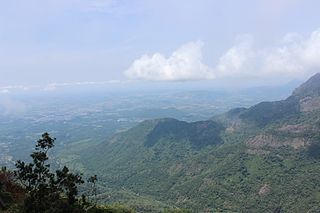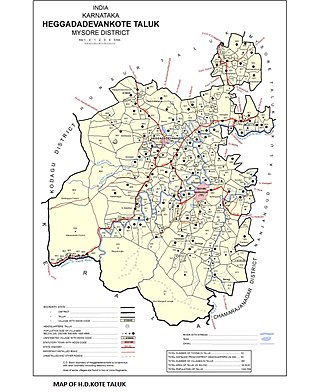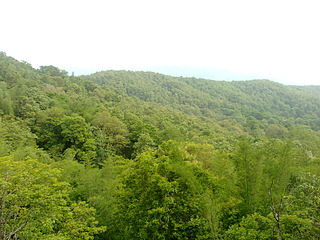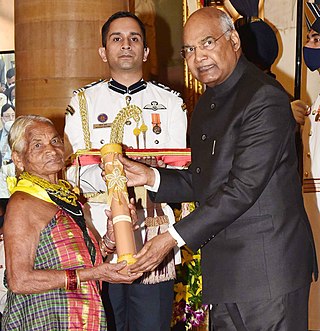Related Research Articles

Chamarajanagar or Chamarajanagara is the southernmost district in the state of Karnataka, India. It was carved out of the original larger Mysore District in 1998. Chamarajanagar town is the headquarters of this district.

Soliga, also spelled Solega, Sholaga and Shōlaga, is an ethnic group of India. Its members inhabit the mountain ranges mostly in the Chamarajanagar district of southern Karnataka and Erode district of Tamil Nadu. Many are concentrated in the Biligiriranga Hills and associated ranges, mainly in the talukas Yelandur, Kollegal and Chamarajanagar of Karnataka. The Soliga speak Sholaga, which belongs to the Dravidian family. Under Indian law, they are recognized as a scheduled tribe, they have a population of around 40,000.

Wayanad is a district in the north-east of the Indian state of Kerala, with administrative headquarters at the municipality of Kalpetta. It is the only plateau in Kerala. The Wayanad Plateau forms a continuation of the Mysore Plateau, the southern portion of Deccan Plateau which links the Western Ghats with the Eastern Ghats. It is set high in the Western Ghats with altitudes ranging from 700 to 2,100 meters. Vellari Mala, a 2,240 m (7,349 ft) high peak situated on the trijunction of Wayanad, Malappuram, and Kozhikode districts, is the highest point in Wayanad district. The district was formed on 1 November 1980 as the 12th district in Kerala, by carving out areas from Kozhikode and Kannur districts. An area of 885.92 km2 in the district is forested. Wayanad has three municipal towns—Kalpetta, Mananthavady and Sulthan Bathery. There are many indigenous tribes in this area. The Kabini River, a tributary of Kaveri River, originates at Wayanad. Wayanad district, along with the Chaliyar valley in the neighbouring Nilambur in Malappuram district, is known for natural gold fields, which are also seen in other parts of the Nilgiri Biosphere Reserve. Chaliyar river, which is the fourth longest river of Kerala, originates on the Wayanad plateau. The historically important Edakkal Caves are located in Wayanad district.

The Nilgiris district is one of the 38 districts in the southern Indian state of Tamil Nadu. Nilgiri is the name given to a range of mountains spread across the borders among the states of Tamil Nadu, Karnataka and Kerala. The Nilgiri Hills are part of a larger mountain chain known as the Western Ghats. Their highest point is the mountain of Doddabetta, height 2,637 m. The district is contained mainly within the Nilgiri Mountains range. The administrative headquarters is located at Ooty. The district is bounded by Coimbatore to the south, Erode to the east, and Chamarajnagar district of Karnataka and Wayanad district of Kerala to the north. As it is located at the junction of three states, namely, Tamil Nadu, Kerala, and Karnataka, significant Malayali and Kannadiga populations reside in the district. Nilgiris district is known for natural mines of Gold, which is also seen in the other parts of Nilgiri Biosphere Reserve extended in the neighbouring states of Karnataka and Kerala too.

The Adivasi are a heterogeneous tribal groups across the Indian subcontinent. The term is a Sanskrit word coined in the 1930s by political activists to give the tribal people an indigenous identity by claiming an indigenous origin. The term is also used for ethnic minorities, such as Chakmas of Bangladesh, Bhumiputara Khasas of Nepal, and Vedda of Sri Lanka. The Constitution of India does not use the word Adivasi, instead referring to Scheduled Tribes and Janjati. The government of India does not officially recognise tribes as indigenous people. The country ratified the International Labour Organization (ILO) Convention 107 on Indigenous and Tribal Peoples of the United Nations (1957) and refused to sign the ILO Convention 169. Most of these groups are included in the Scheduled Tribe category under constitutional provisions in India.

The Nilgiri Biosphere Reserve is a biosphere reserve in the Nilgiri Mountains of the Western Ghats in South India. It is the largest protected forest area in India, spreading across Tamil Nadu, Karnataka and Kerala. It includes the protected areas Mudumalai National Park, Mukurthi National Park, Sathyamangalam Wildlife Sanctuary in Tamil Nadu; Nagarhole National Park, Bandipur National Park, both in Karnataka; Silent Valley National Park, Aralam Wildlife Sanctuary, Wayanad Wildlife Sanctuary, and Karimpuzha Wildlife Sanctuary in Kerala.

Wayanad Wildlife Sanctuary is a wildlife sanctuary in Wayanad, Kerala, India with an extent of 344.44 km2 (132.99 sq mi) and four hill ranges namely Sulthan Bathery, Muthanga, Kurichiat and Tholpetty. A variety of large wild animals such as gaur, Indian elephant, deer and Bengal tiger are found there. There are also quite a few unusual birds in the sanctuary. In particular, Indian peafowl tend to be very common in the area. Wayanad Wildlife Sanctuary is the second largest wildlife sanctuary in Kerala. It is bestowed with lush green forests and rich wildlife. This wildlife area houses some of the rare and endangered species of both flora and fauna.

Nagarahole National Park is a national park located in Kodagu district and Mysore district in Karnataka, India.
The Tea-garden community is a term for a multiethnic, multicultural group of tea garden workers and their descendants in Assam. They are officially referred to as Tea-tribes by the government of Assam and notified as Other Backward Classes (OBC). They are the descendants of peoples from multiple tribal and caste groups brought by the British colonial planters as indentured labourers from the regions of present-day Jharkhand, Odisha, Chhattisgarh, West Bengal and Andhra Pradesh into colonial Assam during the 1860-90s in multiple phases to work in tea gardens. They are found mainly in those districts of Upper Assam and Northern Brahmaputra belt where there is a high concentration of tea gardens, like Kokrajhar, Udalguri, Sonitpur, Biswanath,Nagaon, Golaghat, Jorhat, Sivasagar, Charaideo, Dibrugarh, Tinsukia, and Lakhimpur. There is a sizeable population of the community in the Barak Valley region of Assam as well in the districts of Cachar, Karimganj and Hailakandi. The total population is estimated to be around 7 million, of which an estimated 4.5 million reside in residential quarters built inside 799 tea estates spread across tea-growing regions of Assam. Another 2.5 million reside in the nearby villages spread across those tea-growing regions. They speak multiple languages, including Sora, Odia, Assam Sadri, Sambalpuri, Kurmali, Santali, Kurukh, Kharia, Kui, Chhattisgarhi, Gondi and Mundari. Assam Sadri, distinguished from the Sadri language, serves as lingua franca among the community.

Sargur, is a small town located about 80 km from the town of Chamarajanagar And a Taluk of Mysore district of Karnataka, India. H D Kote (Heggadadevanakote) is about 12 km north of Sargur. It is 55 km from the city of Mysore. Bangalore International Airport is 200 km away. To be more elaborate, Sargur is 33.8 km from Nanjangud town (Karnataka), 35.1 km from Gundlupet town (Karnataka), 137.8 km from Udagamandalam town (Ooty) Valley and 38.8 km from Hunsur town (Karnataka).

Parambikulam Tiger Reserve, which also includes the erstwhile Parambikulam Wildlife Sanctuary, is a 643.66 square kilometres (248.5 sq mi) protected area lying in Palakkad district and Thrissur district of Kerala state, South India. The Wildlife Sanctuary, which had an area of 285 square kilometres (110 sq mi) was established in part in 1973 and 1984. It is in the Sungam range of hills between the Anaimalai Hills and Nelliampathy Hills. Parambikulam Wildlife Sanctuary was declared as part of the Parambikulam Tiger Reserve on 19 February 2010. Including the buffer zone, the tiger reserve has a span of 643.66 km2. The Western Ghats, Anamalai Sub-Cluster, including all of Parambikulam Wildlife Sanctuary, has been declared by the UNESCO World Heritage Committee as a World Heritage Site. The Tiger Reserve is the home of four different tribes of indigenous peoples including the Kadar, Malasar, Muduvar and Mala Malasar settled in six colonies. Parambikulam Tiger Reserve implements the Project Tiger scheme along with various other programs of the Government of India and the Government of Kerala. The operational aspects of administering a tiger reserve is as per the scheme laid down by the National Tiger Conservation Authority. People from tribal colonies inside the reserve are engaged as guides for treks and safaris, and are provided employment through various eco-tourism initiatives. Parambikulam Tiger Reserve is among the top-ten best managed Tiger Reserve in India. The tiger reserve hosts many capacity building training programmes conducted by Parambikulam Tiger Conservation Foundation in association with various organisations.
Kattunayakar or Jennu Kurumbas an indigenous community, is a designated scheduled tribe in the Indian states of Tamil Nadu, Karnataka, Kerala, and Andhra Pradesh. The word Kattunayakar காட்டு நாயகர் / ಕಾಡು ನಾಯಕರು means the king of the jungle in Tamil and Kannada. The Kattunayakar are one of the earliest known inhabitants of the Western Ghats, who are engaged in the collection and gathering of forest produce, mainly wild honey and wax.

Sathyamangalam Tiger Reserve is a protected area and tiger reserve located along the area straddling both the Western Ghats and Eastern Ghats in the Erode District of the Indian state of Tamil Nadu. The Sathyamangalam Forest Division is part of the Bramhagiri-Nilgiris-Eastern Ghats Elephant Reserve notified in 2003. In 2008, part of the Sathyamangalam Forest Division was declared as a wildlife sanctuary and enlarged in 2011, it covers a forest area of 1,411.6 km2 (545.0 sq mi). It is the largest wildlife sanctuary in Tamil Nadu. In 2013, an area of 1,408.6 km2 (543.9 sq mi) of the erstwhile sanctuary was notified as a tiger reserve. It was the fourth tiger reserve established in Tamil Nadu as a part of Project Tiger and is the third largest in the state.

Sigur Plateau is a plateau in the north and east of Nilgiri District in the Nilgiri Hills of Tamil Nadu, South India. It covers the 778.8 square kilometres (300.7 sq mi) portion of the Moyar River drainage basin on the northern slopes of the Nilgiri Hills, south of the Moyar River.
The Muthanga Incident refers to an incident of police firing on the Adivasis in the Muthanga village of Wayanad district, Kerala. On 19 February 2003, the Adivasis had gathered under Adivasi Gothra Maha Sabha (AGMS) to protest the Kerala Government's delay in allotting them land, which had been contracted in October 2001. During the protest, Kerala Police fired 18 rounds resulting in two immediate fatalities. In a subsequent statement, the Government placed the official death toll at five. A video of the firing was aired on several news programs.

Tulsi Gowda is an Indian environmentalist from Honnali village, Ankola taluk in Karnataka state. She has planted more than 30,000 saplings and looks after the nurseries of the Forest Department. Her work has been honoured by the Government of India and other organisations. In 2021, the Government of India awarded her the Padma Shri, the country's fourth highest civilian award. She is known as the "Encyclopedia of the Forest" for her ability to recognise the mother tree of any species of tree.

The Katkari also called Kathodi, are an Indian tribe from Maharashtra. They have been categorised as a Scheduled tribe. They are bilingual, speaking the Katkari language, a dialect of the Marathi-Konkani languages, with each other; they speak Marathi with the Marathi speakers, who are a majority in the populace where they live. In Maharashtra the Katkari have been designated a Particularly vulnerable tribal group (PVTG), along with two other groups included in this sub-category: the Madia Gond and the Kolam. In the case of the Katkari this vulnerability derives from their history as a nomadic, forest-dwelling people listed by the British Raj under the Criminal Tribes Act of 1871, a stigma that continues to this day.

Kurumbas (or) Kurumbar are a designated Scheduled Tribe or an indigenous community in the Indian states of Karnataka, Kerala and Tamil Nadu. The Kurumbar are one of the earliest known inhabitants of the Western Ghats, who are engaged in the collection and gathering of forest produce, mainly wild honey and wax. The members of this community are short, have dark skin, and have protruding foreheads.

Mysore-Ooty Road or Mysore-Udhagamandalam Road is a tourist trail of South India starting from Mysore in Karnataka state and ending in Udhagamandalam in Nilgiri district of Tamil Nadu state, India. Both routes pass through Bandipur National park in Gundlupet, Karnataka and Mudumalai National Park in Tamil Nadu.
Jenu Kurumba, also known as Jen Kurumba, is a Southern Dravidian language of the Tamil–Kannada subgroup spoken by the Jennu Kurumba/Kattunayakan tribe. It is often considered to constitute a dialect of Kannada; however, Ethnologue classifies it as a separate language. Jenu Kurumba speakers are situated on the Nilgiri Hills cross-border area between Tamil Nadu and Karnataka, Mysore and Kodagu districts of Karnataka, and Wayanad district of Kerala. The speakers of the language call it "nama basha".
References
- ↑ Tribes in Karnataka: Status of health research.
- ↑ "As India's tiger count grows, Indigenous groups protest evictions from ancestral lands". PBS NewsHour. 2023-04-09. Retrieved 2024-02-20.
- 1 2 Thurston, Edgar. (1993). Castes and tribes of Southern India. Vol. 4. Asian Educational Services. ISBN 81-206-0291-9. OCLC 734094928.
- ↑ Girisha (15 July 2020). "Karnataka tribals evicted from Bandipur in the 1970s allege raw deal in relocation". The News Minute . Retrieved 2020-08-06.
- ↑ Kumar H, Pavan (2019-03-03). "Indigenous dwellers can be evicted only with consent". Deccan Herald. Retrieved 2019-08-20.
- ↑ Lakshmikantha BK (Jul 16, 2020). "Aggrieved Jenu Kuruba community members write to PM Modi seeking justice | Mysuru News - Times of India". The Times of India. Retrieved 2020-08-05.
- ↑ "Over 6,000 Jenu Kuruba Adivasis in Karnataka Begin Indefinite Protests against Tiger reserve". www.newclick.in. 2021-03-24. Retrieved 2021-04-16.
… The community has accused the state government and the forest department alongside the Wildlife Conservation Society of trying to forcefully evict them from the forest in a bid to pave way for eco-tourism activities while trampling on the Adivasis' rights to the forest and land.
IN THE NAME OF TIGER CONSERVATION
The struggle for land rights by the traditional honey collecting community has been going on since the 1970's …